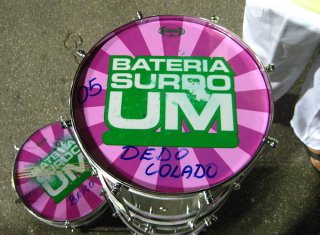unique baterias
Another busy night tonight.... Bangalafumenga, Sao Clemente, Trapiche Gamboa, then the obligatory "but we still haven't drunk our 15 chopp beers yet" and resulting two-hour visit to the justly famous Bar Belmonte in Flamengo. GREAT night. It was especially fun to have such a good gang to hang out with - a mix of my choro gang and my escola gang.
more about the name-that-escola recording:
first off, I got some email responses, and yup, most of you got it!
1. Imperio Serrano
2. Mangueira
3. Mocidade
4. Beija-Flor
some more info:
1. Imperio Serrano - because of the quad bells. (this could also have been Grande Rio; but only Imperio has enough quad bells for them to be that audible from across the caixas and surdos).
2. Mangueira - Instantly identifiable because of the lack of a second surdo. They just have a first surdo hitting the "2", and that is their odd little surdo called a cortador, or cutter, that occasionally fills in offbeats. This little recording captures a cortador player who does a classic sequence. (never mind about why the first surdo is called "first" if it is hitting the "2" - just accept it)
I noticed that this year, Mangueira's bateria slogan is "Bateria Surdo Um!" (Bateria One Surdo!). It is printed on all the drum heads. They were also all wearing t-shirts that said, in Portuguese, "You gotta respect my one surdo!"

(the "Dedo Colado" written on the drum head is the drummer's name - "Glue Finger"!)
If you listen to the full Mangueira recording (I posted a longer version) you'll also notice a couple other things. A bank of agogos go by - Mangueira's the only large escola that I've seen that uses agogos. And cuicas keep popping into view (auditorally), because Mangueira scatters the cuicas among the caixas and surdos instead of putting them in the front row.
Mangueira is NOT instantly identifiable by caixa pattern, or at least, not by me. The caixa pattern is not the oddity that it's been taught to be in many American groups. Americans tend to overemphasize the double-right hits, and to play the left hand way too soft. In reality - most Mangueira caixa players simply rattle along with a very classic rocketing samba swing, in which the double-right hits are either inaudible, or they are using another sticking entirely that doesn't even have any double-rights. If you really want to sound like Mangueira: forget the double-rights and work on your swing instead.
3. Mocidade - Caixas are playing pure "bossa clave", and the surdos are inverted in tuning; the second surdo (playing the 1) is lower pitched than the first surdo (playing the 2). In combination, you get this melody:
"Boom, ba-bim, ba, boom, ba, bim-ba!"
ok, maybe that doesn't make any sense to anyone but me.... but to me it is the sound of Mocidade!
Mocidade caixa players all play single-stroke (left and right hand alternating). And the caixa swing is not as strong as in other escolas.
4. Beija-Flor - the giveaway is at the break when the frigideiras (frying pans) enter! I love these little frigideiras. They swing like crazy and it's always such a kick in the pants when they enter. I decided today that I should buy one. Everybody needs a tiny frying pan to play in a samba band, don't they?
You might also detect a "shk, shk" sound buzzing softly in the background. Beija-Flor's got some shekeres. The huge kind. They're not usually that audible, but they were threading their way through the bateria just then, because Beija-Flor, like many baterias these days, enters the recuos "head-first" and has to reorganize afterwards. The baterias have to pull off the parade route and "park" in side streets, recuos, twice during the parade. Entering head-first saves time because it allows the parade to keep moving. (As opposed to the bateria walking past the recuo, stopping, then backing up into it, which puts the instruments in the right sequence for moving out again; but the whole parade has had to stop.) But after a head-first entrance, then the "front instruments" have to manuever their way to the other end of the bateria somehow.
Mangueira has trained its drummers in a complicated manuever with columns of drummers moving past each other; Beija-Flor just has the "front instruments" walk single file down a center column to the other end of the bateria. (the back instruments remain out of order, but it doesn't really matter.)

1 Comments:
Kat! I love your blog. I just devour all the great information on samba. You are so knowledgeable! Thanks so much for the percussion school tips. Hopefully, we'll get a chance to meet in Rio.
Post a Comment
<< Home